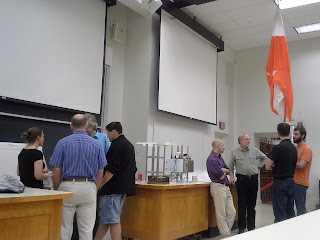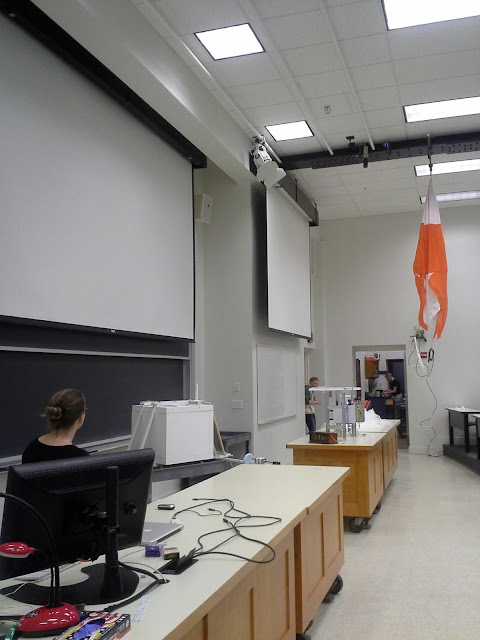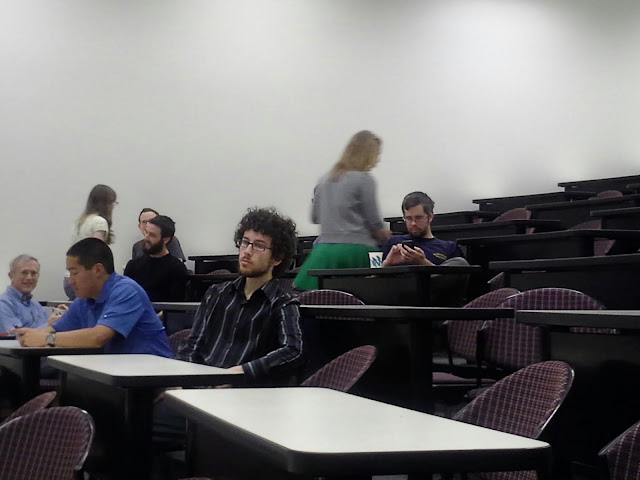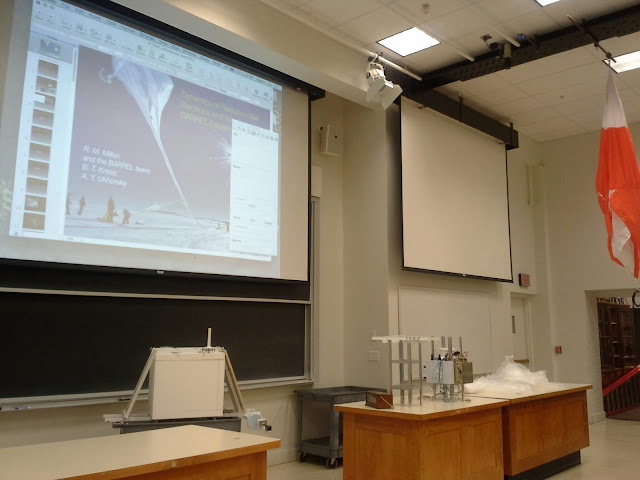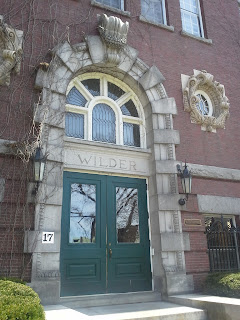The NASA satellite Solar Dynamic Observatory (SDO) has put together a great movie showing the dynamics on the sun over a three year period - in three minutes.
There is an article at NPR accompanying this movie. I found a lot of the comments interesting. A common question that can up was does the sun spin or is the spinning due to the Earth? Yes, the Sun spins around it's own axis and is made up of hot ionised gas which we call plasma. Plasma acts kind of like a liquid, so different parts of the sun will rotate at different rates. Near the Sun's equator it rotates once ever 25 days or so while at the Sun's poles it's closer to 30 days. This is pretty impressive if you consider that it takes the Earth ~1/27 = 0.037 of a Sun's rotation to rotate and the Sun is ~109 Earth's across!
Although the sunspots, flares, brightenings on the Sun all appear to be in two belts, They actually go through what we call the Butterfly pattern. At the beginning of a solar cycle (11 year period) These regions are found closer to the poles. As time goes on they move towards the equator. This solar cycle is where the Sun's magnetic field reverses, so the south pole becomes the north and the north pole becomes the south. Our magnetic field also does this, but on a much longer time scale.
The Sun is incredibly interesting and so important to life here on Earth. There are quiet a few great missions which focus on studying the Sun. If you want to check out more wonderful photos and videos search for SOHO and STEREO. STEREO is actually two satellites looking at the Sun in stereo allowing us to get some amazing 3-D images of the Sun! One of the Satellites is trailing us in our orbit while the other is running ahead of us. At the moment they are situated so that we can actually see what is going on behind the Sun as well for the first time!
Enjoy,
The Balloon Array for Radiation belt Relativistic Electron Losses is a NASA sponsored, multiple-balloon investigation that studies Earth's radiation belts.
Wednesday, April 24, 2013
Monday, April 22, 2013
Robyn's Physics Colloquium video
As promised, here is Robyn's physics colloquium talk! It really was fun to see our entire campaign summarised with a great introduction. If you've ever wondered what it is we do exactly or what space physics even is, this has some great info at the beginning.
Colloquium Abstract - April 19, 2013
Robyn Millan, Dartmouth College
Topic: "Dynamics of Radiation Belt Electrons and the BARREL Experiment"
Abstract: The intensity of relativistic electrons in Earth's radiation belts is known to be highly variable, but the processes responsible for this variability are still not well understood. Observed rapid depletions and subsequent rebuilding of the trapped particle population imply an efficient energization process, in some cases accelerating electrons to multiple MeV energies on a timescale as short as minutes. NASA's two Van Allen Probes were launched in August 2012 to study the radiation belts. BARREL is a multiple-balloon investigation that works with the Van Allen Probes to study atmospheric loss of radiation belt electrons. The first BARREL balloon campaign was carried out in January-February 2013. Twenty small (~20 kg) balloon payloads were launched from the SANAE IV and Halley VI Antarctic research stations. A second campaign will be carried out next year. This talk will provide an introduction to radiation belt physics, and will summarize early results from BARREL and Van Allen.
I'll see if we can get the actual video to upload here, but in the mean time, just click on the link.
GOES-R Movie Trailer
A New GOES Satellite is on it's way and not too soon either.
We use the GOES satellites and their data a lot! They provided some great data to help us forecast space weather during this last campaign. We were able to confirm that we saw an x-ray flare from the sun with our balloons due to GOES. We were able to see waves and their associated plasma parameters which may be the cause for some of our observed precipitation, and the list goes on. This is great news that we'll be getting a new GOES satellite in a few years!
We use the GOES satellites and their data a lot! They provided some great data to help us forecast space weather during this last campaign. We were able to confirm that we saw an x-ray flare from the sun with our balloons due to GOES. We were able to see waves and their associated plasma parameters which may be the cause for some of our observed precipitation, and the list goes on. This is great news that we'll be getting a new GOES satellite in a few years!
Friday, April 19, 2013
Dartmouth Physics Colloquium: BARREL edition
Today Robyn gave the Physics Colloquium at Dartmouth College. Brett provided and set up all the show and tell portions of the talk. It made an impressive display. We had a buttoned up payload (the white box), the insides and just the frame along with the parachute and a ripped balloon from this last years campaign. Once the link to the video is up we'll make sure to let everyone know.
I thought it was cool how you could see the payload here and then in the photo, but that didn't turn out too well, so I tried again
Our Icon with the entire payload.
Some spectrograms which show those "Alien Birds"
Afterwards people came up and were able to feel just how thin and strong our balloons are. It's quiet amazing to think that they can go through these large temperature changes and carry our payloads all without breaking. The technology used is just so cool!
Barrel physics colloquium.
Labels:
Papers/presentations,
photos,
Science Discussion
Location:
Hanover, Hanover
Thursday, April 18, 2013
New Page! Fun with Google Earth
Hi all,
So if you have noticed we have a new page. We are in the process of getting our BARREL position files to run interactively from the blog. At the moment we have a first draft so go check it out and have a bit of fun with it! We're still re-processing some of the data so not all file names will have the "_L_MLT" portion of the file name. Those that do include the L-value and Magnetic local time (MLT) data with them while the others do not. I'm hoping that now that we have this working somewhat it won't take too much effort to add other satellite footprints and the lines of constant L.
If you have any suggestions on how to make this better let me know! We'll see if we can add in any suggested features. Currently on the list of things to add we have
Have fun with it!
So if you have noticed we have a new page. We are in the process of getting our BARREL position files to run interactively from the blog. At the moment we have a first draft so go check it out and have a bit of fun with it! We're still re-processing some of the data so not all file names will have the "_L_MLT" portion of the file name. Those that do include the L-value and Magnetic local time (MLT) data with them while the others do not. I'm hoping that now that we have this working somewhat it won't take too much effort to add other satellite footprints and the lines of constant L.
If you have any suggestions on how to make this better let me know! We'll see if we can add in any suggested features. Currently on the list of things to add we have
ground based magnetometer locationsAdded!option to show Van Allen Satellite southern hemispheric footprintAdded!- s
how lines of constant LAdded! our "colour bar" for MLTAdded!- Possibly include a view of the Satellite orbit with the balloon footprints at the magnetic equator.
- choose a date and then what you want to plot (payloads, satellites, ect. )
Have fun with it!
Now you too can make your own plots of our payloads!
Wednesday, April 17, 2013
BARREL at Physics Colloquium this Friday
In case you happen to be in the Hanover Area this Friday, Robyn will be giving the physics Colloquium at 3:30. These are normally recorded so as long as nothing goes wrong we'll have video for those who can't make it in person.
Hope to see you all there,
Tuesday, April 16, 2013
Space Physics at Dartmouth
Dartmouth Now just published a great article about Robyn and Mary and the work they are doing on the Van Allen Satellites and BARREL. It's a great synopsis of both missions and why they work so well together. There's also a great gallery of photos from both the Van Allen Satellites and BARREL.
News from Wilder
Reflections on Becoming the Science Communicator. Part three (and the scariest) Video
The EPSCoR Becoming the Messenger workshop was really incredibly useful and insightful! I only wish I had more time to work through all the topics we discussed. It was a whirl wind experience and one I hope to not forget anytime soon. Here without final ado is...
The final reflection. - video.
The video section was perhaps the most useful and the most embarrassing. It's amazing today how easy it is to make a video. If you've been following our blog you've seen a few of my attempts already. However at the meeting we got some great tips on how to make them look much more professional... with only the use of a phone or flip cam. Once again the layout was the same. Have a strong message with three pillars to really hold it up. Once you've got your message and structure you also need a call to action and of course some visual support. I found it interesting how this call to action was really related to letting your audience in, making them feel that they have a stake in this to and can do something about it.
All of these public out reach forums are things that as a scientist one never thinks they are going to do. One does not go into science to start a blog or become a celebrity and talk with news outlets, but it is something that I'm finding is really important. We become scientist, for the most part, because we love to figure things out and want to understand the world around us. But it is so important for us to also be able to show and communicate our results to the larger community. I suppose that means that at least to a certain degree I better get use to hearing my own voice or seeing myself in a video.
In the task given to us we were asked to film our message in three shots, an opening statement in a wide shot, our three main points in a tight shot, and then our closing statement in a wide shot. As you can see we didn't quiet make that.
The opening statement was suppose to pull the audience in. Thus my attempt at a funny story about how space weather gave me a snow day in school for at least one class. And that's where I then started to realise I was running out of time (we had less than 2 mins to talk). The next section was suppose to really convey concisely (not a strong point for me) what we wanted people to take away from the video. And in the closing statement, instead of rushing to a result, one is suppose to restate your message and "galvanise" your audience.
Here is my attempt. (If you notice I also took the time to add some "B-roll" of the flights of our payloads.)
And because I made you all sit and listen to me, here is a wonderful lecture about some early astrophysics ballooning by perhaps the best physics educator ever Prof. Walter Lewin. Thank you stratocat for pointing me to this clip.
Monday, April 15, 2013
Congrats to CalFigure skating and Dartmouth
I know this has nothing to do with space physics, but it has a space tie in I promise!
This past weekend was the College Figure Skating Championships held right here in Hanover NH. In a past life (pre-grad school) I was a figure skater and in my very limited free time I try to help teach at the local club. So of course I went and watched and low and behold two of the schools in the BARREL mission were there, Dartmouth (the reining champions) and Cal Berkley. During the Senior mens event I was ecstatic to see that Cal's skater Sean Sunyoto skated to a star trek inspired piece. I also think that he won best costume award. I couldn't get a great picture, but you get the idea. It's a star trek uniform. Awesome.
Anyway, Happy monday and congrats to Dartmouth on a silver place finish and to Cal on their fourth place finish! Both teams skated very well.
This past weekend was the College Figure Skating Championships held right here in Hanover NH. In a past life (pre-grad school) I was a figure skater and in my very limited free time I try to help teach at the local club. So of course I went and watched and low and behold two of the schools in the BARREL mission were there, Dartmouth (the reining champions) and Cal Berkley. During the Senior mens event I was ecstatic to see that Cal's skater Sean Sunyoto skated to a star trek inspired piece. I also think that he won best costume award. I couldn't get a great picture, but you get the idea. It's a star trek uniform. Awesome.
Anyway, Happy monday and congrats to Dartmouth on a silver place finish and to Cal on their fourth place finish! Both teams skated very well.
Reflections on Becoming the Science Communicator. Part 2 The Message
The Message:
The message session was all about the triangle. Have a main point and three attributes holding up that main point. It's a great way to "Frame" your talk. Framing was another buzz word which really helped me "picture" the outline of my talk (sorry I couldn't resist). When framing a picture you might not include the whole thing, but you do make sure to frame and highlight the parts that resonate with the viewer. A talk should have the same thing.
The majority of the talks that we discussed were those to a more general audience. Perhaps a 5 minute presentation to a group of citizen scientist. Man, in 5 minutes I'm not sure I can even define what space physics is! However, as you'll see in the attached video in the next post, I gave it a good try.
During all the sections we had some great worksheets to go through. I think it really helps. On the most useful one they gave us 10 points to think about. I've included what I try to think about while writing blog post, however I would be really interested to know who reads our posts, and what you think we should be focusing on.
The first is pretty obvious for us:
1) I'm going to talk about: BARREL and space physics.
The next few are who I think tends to read our posts now that the 2013 campaign has finished. Is this a correct guess? How much do you are readers know about space physics/space weather and Antarctic Balloon missions?
2) My audience is: The citizen scientist
3) My message is targeted to this one type of person in the audience: Scientifically-friendly with some science literacy. Friends and family of out colleagues who may or may not be scientist themselves.
4) Relative to what I'm talking about they know: Perhaps that space physics has something to do with the aurora and explosions on the sun.
5) This makes them (supportive/resistant): Supportive!
6) The audience will respond most favourably if I make my points in the context of: science, effects on technology, and personal involvement.
The next ones really touches on what we hope you the reader leave with after reading our blog.
7) Relative to what I'm talking about I want the reader to believe: that scientific research is important, fun, and really interesting. It is something that helps not just our understanding of the world around us, but leads to advancements in technology, other areas of scientific research, and better lives.
8) Three things that the audience show walk away knowing about this subject
- What space physics/ space weather is.
- Why we want to be able to predict space weather events.
- How Balloon missions can add greatly to this endeavour of understanding our Sun-Earth environment and someday being able to predict space weather events.
- The 1989 power outage which blacked out most of the north Eastern coast.
- The day the pagers died (or Lyods of London provide space weather insurance. I can't make up my mind which is more compelling. )
- BARREL has been a success!
And finally, I will be reaching my audience through: A Blog!
So how do you think I've done so far? Have I sucessfully understood who my audience is?
And tomorrow, the conclusion and the embarrassing one take video...
Thursday, April 11, 2013
Reflections on Becoming the Science Communicator. Part 1 Twitter.
When we first started this blog I think we all felt like beginners. I still feel like a beginner, but after the workshop I think I'm one step closer to understanding all this social media. On Wednesday NSF NH-EPSCoR held a workshop on becoming a science communicator. We talked about twitter, creating a solid message, powerpoint presentations, videos, and of course Blogging. As I was writing up all that I had learned, it was obvious that the post was becoming really long so I've divided it up into three sections, Twitter, The Message, and the Video.
I think the main point I got from yesterday is that you need to just put yourself out there. You will make mistakes, but with practice and some forethought you should be fine. So this is an experiment for myself, and hopefully along the way I'll be able to impart why I think space physics, and space physics with Balloons is just so incredibly cool!
Twitter:
I had a twitter account, but I had never really used it till the workshop. Man was it fun when people really started to get into it. The presenters had four screens, two showing the presentations and two showing the tweets trending on #NSFMessengers. We even got people who came to previous workshops tweeting with us. It was amazing how a topic would come up and all of a sudden people would be tweeting relevant links and adding to the discussion.
At the beginning of the campaign we had talked about having a BARREL twitter account. Since none of us were all to familiar with it we decided to focus our efforts on other things, like this blog! However after the workshop I went online and signed us up. You can now follow us at BARREL_Antarctic. I'm hoping that we can use this tool to not only reach more people, but to get information out there even faster than before.
Tweets by @BARREL_Antartic
Wednesday, April 10, 2013
Becoming a science communicator.
Today I (Alexa) am attending an NSF EPSCoR workshop on science communication. Hopefully I'll learn some really cool tricks and be able to improve this blog to make it even more awesome. Thus far today we've learned about twitter, and how about why many science communications fail. It's been really interesting and I hope to learn a lot more. In the mean time, this gives me an excuse to show two videos of my favourite science communicators. Bill Nye the Science guy and Neil deGrasse Tyson. I hope you enjoy!
Monday, April 8, 2013
Monday April 8th 2013 BARREL Science meeting #2
Hi all,
This is just a friendly reminder that we will have our second BARREL Science telecom at 1:00 PST on April 8th (today). We have 3 graduate students giving brief talks on what they are working on with the BARREL data. It should be a good one, so you won't want to miss it!
Carol will be showing some ground based data with GOES wave data on the 17th events. Zan will be presenting on her modelling activities and how this will lead to modelling specific events. Last but definitely not least we will have Andrew talking about micro bursts.
If you have not received the e-mail with the meeting information and would like to attend, please let me know and we'll add you to the list.
Have a great week!
This is just a friendly reminder that we will have our second BARREL Science telecom at 1:00 PST on April 8th (today). We have 3 graduate students giving brief talks on what they are working on with the BARREL data. It should be a good one, so you won't want to miss it!
Carol will be showing some ground based data with GOES wave data on the 17th events. Zan will be presenting on her modelling activities and how this will lead to modelling specific events. Last but definitely not least we will have Andrew talking about micro bursts.
If you have not received the e-mail with the meeting information and would like to attend, please let me know and we'll add you to the list.
Have a great week!
Wednesday, April 3, 2013
The ISS
Over the last few weeks I've seen a few great reports on the International Space Station (ISS). The first one is from the Atlantic. They have 40 photos from the ISS. I can't believe that it's been up and manned for over 13 years. It seems like just yesterday they were starting to build it.
Here is a great video of sounds from space with video from the ISS.
The other report is a wonderful movie about an astro photographer filled with beautiful photos. Some of them are time lapsed so that you can see things like the movement of the Aurora. It's spectacular. Enjoy!
If anyone is looking for an astrophotographer to send into space, I'm sure I can make some room in my schedule.
Here is a great video of sounds from space with video from the ISS.
The other report is a wonderful movie about an astro photographer filled with beautiful photos. Some of them are time lapsed so that you can see things like the movement of the Aurora. It's spectacular. Enjoy!
If anyone is looking for an astrophotographer to send into space, I'm sure I can make some room in my schedule.
Tuesday, April 2, 2013
First Plasma Seminar at Dartmouth for Spring quarter
Today was our first plasma seminar at Dartmouth for the spring quarter and Robyn gave a great summary talk on the BARREL mission and 2013 Campaign. She'll be giving a similar talk at the physics colloquium later this month (I think). Our colloquiums are taped, so we'll put a link to it here once she has given it. In the mean time and as a bit of a teaser, here are some pictures from today's talk.
Our project overview
Our payload up close, and in the air!
Some pretty pictures (Which will hopefully be upload to the blog soon!)
Enjoy!
Monday, April 1, 2013
Rapping science in schools
This is just a neat idea so I wanted to share.
So, the big question... Does anyone out there have a rap about heliospheric physics? Auroras? Solar storms? Balloons? If so, you should send it to us and we'll feature it in a post. A few rules; 1) It must be family friendly 2) it must be accurate and 3) it must be Awesome and/or nerdy. One of my friends did make a mix from our graduate Electromagnetism lectures. It's not space physics, but E&M is a huge part of what we do. If I can find it I promise to share it.
So, the big question... Does anyone out there have a rap about heliospheric physics? Auroras? Solar storms? Balloons? If so, you should send it to us and we'll feature it in a post. A few rules; 1) It must be family friendly 2) it must be accurate and 3) it must be Awesome and/or nerdy. One of my friends did make a mix from our graduate Electromagnetism lectures. It's not space physics, but E&M is a huge part of what we do. If I can find it I promise to share it.
Subscribe to:
Posts (Atom)






